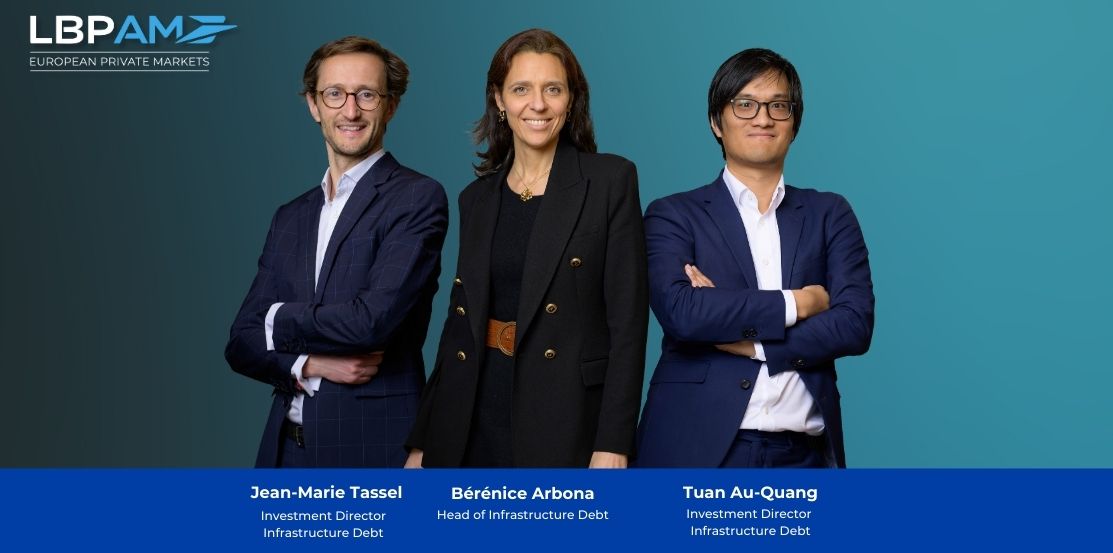Ensuring European competitiveness in a global asset class
03.01.2025|12 min

Infrastructure credit has a crucial role to play in building strength and resilience in the EU economy, say LBP AM European Private Markets’ Bérénice Arbona, Jean-Marie Tassel and Tuan Au-Quang.
Geopolitical tensions are reinforcing the need for European infrastructure investment. The Draghi report, commissioned by the EU Commission to garner the view of former European Central Bank President Mario Draghi on securing the continent’s future competitiveness, emphasises the need for significant funding across multiple sectors. And with public finances remaining constrained, the need for private capital is only growing.
Infrastructure credit will have a particularly important role to play, say LBP AM’s Bérénice Arbona, head of infrastructure debt, Jean-Marie Tassel and Tuan Au-Quang, investment directors infrastructure debt, fuelling the energy transition and related energy independence, as well as digitalisation. Meanwhile, the funding required to facilitate these mega-trends will increasingly come not only from institutions but from private wealth and retail channels.
What are the primary trends influencing Europe’s infrastructure debt market in 2025?
Bérénice Arbona: The Draghi report highlights the necessity of investing in the competitiveness of European territories. Private capital will play a key part in fulfilling that investment need in 2025, given public financing constraints. This includes private infrastructure credit.
Another big trend influencing the infrastructure debt market this year will be the democratisation of the asset class. Infrastructure debt began as a banking market before opening up to institutional investors following the global financial crisis. In my view, 2025 will be the year when the asset class opens up further, becoming truly accessible to professional and retail investors, made possible by the European Long-Term Investment Fund (ELTIF) framework. This new source of funding will coincide with the need for more private infrastructure debt capital to fund the mega-trends of our time.
What about the energy transition? How is that opportunity set evolving and what role does infrastructure debt have to play?
BA: Europe’s priorities pertaining to the energy transition are set in stone. We have fixed targets relating to decarbonisation and we continue to work towards those, despite headwinds elsewhere in the world. In terms of the opportunity set, the energy transition has moved beyond traditional renewable generation assets and we will see a greater emphasis on energy efficiency, network capacity and battery storage this year.
Jean-Marie Tassel: Energy transition is about more than just renewables. Renewables are inherently intermittent, which has led to the emergence of a complementary asset class – energy storage. We see batteries, in particular, as key to the energy transition in 2025. Other interesting sectors of the transition that we are financing include EV charging, demand response, energy efficiency and bio-energies, all areas that can generate a complexity premium for us as a lender.
The nature of the projects that we back also depends on the country concerned, what its objectives are and the nature of its energy mix. Many renewables have come online in Spain, for example, so recent projects we have backed tend to be centred around adding baseload to the mix, rather than financing additional renewables capacity. It is important for us to focus on where the need is greatest and where the impact will be most pronounced.
Which sectors are likely to dominate this year?
BA: If I had to pick one sector that would dominate in 2025 it would have to be data centres. Last year was all about refinancing big fibre-to-the-home platforms, but fuelled by the acceleration of AI, this year will be the year of the data centre.
What are you looking for in the assets you choose to back?
Tuan Au-Quang: Fundamentally, we look for true infrastructure characteristics, which means remaining disciplined around new sectors and business models. Assets need to provide essential services to society, something that can be reinforced by strong ESG credentials. Cashflow visibility is also critical, backed either by a contractual framework, regulation, or a monopolistic, or at least oligopolistic, position. Another essential component of our underwriting involves sound risk allocation with robust and experienced counterparties. This is particularly key given the new sectors that now fall within infrastructure: in that respect we will not take any technology risk. What we are looking for is an illiquidity premium while remaining within the guidelines of our strategies in terms of risk. And we are mindful of diversification, by sector, geography and risk profile.
What are the main innovations you are seeing in infrastructure debt financing in Europe?
JMT: We’re seeing more junior debt and unitranche solutions being put in place in response to evolving sponsor needs. In addition to single asset projects requiring traditional project finance, sponsors are increasingly pursuing projects located in multiple countries and including multiple sectors, requiring a more corporate approach. For example, they may require different tranches or different lines in the financing including capex for growth, as well as term loans to refinance existing assets. Cashflow from these operating assets can then be used to further develop the project.
We are also seeing more structures tapping into money from different parts of the infrastructure ecosystem, with institutional investors sitting alongside banks. Different pools of capital can have different purposes. Institutional investors have appetite for long-term positions while banks are a better fit for capex facilities, for example.
Another innovation involves the integration of ESG KPIs in structures, providing a roadmap for sponsors towards decarbonisation and other objectives. This can be used by pure player energy transition strategies, but it is particularly relevant for brown to green projects, which are also essential for the energy transition. These KPIs help us to monitor ESG performance through the life of the financing and contribute to the reporting we are providing to our LPs.
How would you describe LP appetite for European infrastructure debt in this new rate environment?
BA: Infrastructure debt yields have increased in line with interest rates, without impacting the defensive characteristics of the asset class. In contrast, the increase in interest rates has created challenges in the equity market with respect to returns. In terms of relative value, therefore, we are seeing lots of LPs that may have started out in infra- structure equity, leaning more towards credit.
Infrastructure debt also provides investors with regular cashflows, something that investors increasingly value given the recent scarcity of exits and the growing realisation that private markets are also illiquid markets. Not only do we have good long-term visibility on the cashflows that our assets generate, but our investors have good long-term visibility on the cashflows they can get from us.
What questions are investors asking in due diligence? What are they looking for from an infrastructure debt manager?
BA: First and foremost, investors are looking for track record and a great team. Those considerations form the foundation of any due diligence. They want to see a long history of dealmaking and realised returns throughout different cycles. They want to know how you fared through covid. How did your transport assets with traffic risk behave during this period, for example? Have you acted proactively to protect your investors? Certainly, it would be very difficult for a first-time manager to raise a first-time fund today. Investors are demanding proof of experience.
With regards to the team itself, investors are looking for stability, expertise and complementary skillsets. Attention is paid to deal-sourcing capabilities. It is all very well saying you have access to the market, but what does that really mean? Investors want to see proof of the relationships that you have with sponsors. They want to know what proportion of your deals are proprietary. They want to see statistics illustrating how many transactions you have evaluated in a year versus how many you have completed, and they want to know what the origination channel was in each case.
Investors also recognise that today’s market is more complex than it has been in the past. It is no longer just a question of processing investment-grade project finance transactions. Deals are now more complex. They are more corporate in nature. Sponsors are often taking a more value-added approach.
Against that backdrop, investors want to understand your credit process. They want to know how you analyse projects; what sensitivity analyses you are conducting and how you interrogate financial modelling. They want to know who is sitting on the investment committee, what their skills are and to what extent the manager is challenged by that investment committee and by the investment process.
Finally, ESG has clearly become an important topic for LPs, but it is no longe enough just to say that you have integrated ESG within your in- vestment process. You need to prove it. LPs will ask to see how you are analysing ESG in your underwriting and they will want to see evidence of how many deals you have rejected due to ESG considerations.
How do you see the European debt market evolving in the current geopolitical environment?
TA: We are living in volatile and com- plex times. However, the relevance of the infrastructure asset class is often exacerbated by geopolitical tensions. These tensions expose vulnerabilities in individual markets, underscoring the need for continued investment to address the essential needs of societies and ensure ongoing resilience.
The Draghi report emphasises the importance of building self-sufficiency within the EU, highlighting the critical need to enhance social infrastructure, particularly in healthcare and education, as well as advancing the circular economy. Meanwhile, the energy transition, transportation and digital infrastructure are the pillars of building robust, resilient and competitive European economies.
Infrastructure and infrastructure debt are not entirely immune from geopolitical risks, but in our view, geopolitical volatility will act as an additional tailwind in many respects, reinforcing the need for investment in domestic infrastructure. The asset class will continue to remain relevant and to thrive.


